Continuous tuning of band gap by strain engineering in new predicted 13H-Si allotrope
IF 2.9
3区 物理与天体物理
Q3 NANOSCIENCE & NANOTECHNOLOGY
Physica E-low-dimensional Systems & Nanostructures
Pub Date : 2025-01-03
DOI:10.1016/j.physe.2025.116177
引用次数: 0
Abstract
Diamond silicon and most of its allotropes have indirect band gaps that do not allow electrons to propagate directly between the valence and conduction band edges due to momentum mismatch, limiting their performance and efficiency in optoelectronic devices. With the rapid development of the optoelectronic industry, searching for new silicon allotropes with adjustable and/or direct band gap has become increasingly urgent. Here, we predict five new silicon allotropes 13H-Si with continuously tunable band gap, high mechanical, dynamic and thermal stability under tensile strain. As expected, besides their adjustable band gaps in a wide range (0.80–1.30 eV), the indirect-to-direct band gap transition can be achieved in these predicted silicon allotrope 13H-Si under tensile strain (4.5–9.0 %) along a- and b-axis. Especially, these predicted 13H-Si not only demonstrate the stronger visible light absorption ability than diamond silicon, but also show the enhanced absorption intensity under axial strain. The current research not only enriches the types of silicon allotropes, but also accumulates data for the application of silicon materials in the field of solar photovoltaics.

求助全文
约1分钟内获得全文
求助全文
来源期刊
CiteScore
7.30
自引率
6.10%
发文量
356
审稿时长
65 days
期刊介绍:
Physica E: Low-dimensional systems and nanostructures contains papers and invited review articles on the fundamental and applied aspects of physics in low-dimensional electron systems, in semiconductor heterostructures, oxide interfaces, quantum wells and superlattices, quantum wires and dots, novel quantum states of matter such as topological insulators, and Weyl semimetals.
Both theoretical and experimental contributions are invited. Topics suitable for publication in this journal include spin related phenomena, optical and transport properties, many-body effects, integer and fractional quantum Hall effects, quantum spin Hall effect, single electron effects and devices, Majorana fermions, and other novel phenomena.
Keywords:
• topological insulators/superconductors, majorana fermions, Wyel semimetals;
• quantum and neuromorphic computing/quantum information physics and devices based on low dimensional systems;
• layered superconductivity, low dimensional systems with superconducting proximity effect;
• 2D materials such as transition metal dichalcogenides;
• oxide heterostructures including ZnO, SrTiO3 etc;
• carbon nanostructures (graphene, carbon nanotubes, diamond NV center, etc.)
• quantum wells and superlattices;
• quantum Hall effect, quantum spin Hall effect, quantum anomalous Hall effect;
• optical- and phonons-related phenomena;
• magnetic-semiconductor structures;
• charge/spin-, magnon-, skyrmion-, Cooper pair- and majorana fermion- transport and tunneling;
• ultra-fast nonlinear optical phenomena;
• novel devices and applications (such as high performance sensor, solar cell, etc);
• novel growth and fabrication techniques for nanostructures

 求助内容:
求助内容: 应助结果提醒方式:
应助结果提醒方式:


